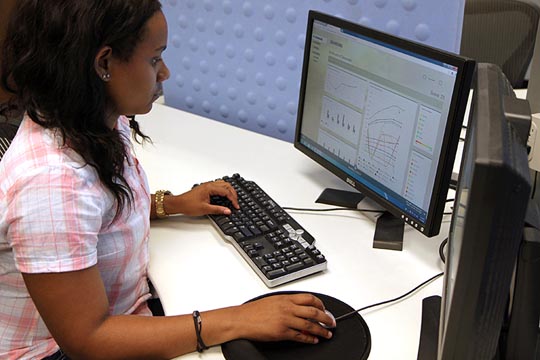A strategic merger of key technology units at The University of Toledo is driving developments in advanced clinical and academic simulations for enriched learning for students across campus.
The Division of Technology and Advanced Solutions is comprised of the Department of Information Technology, the Center for Creative Instruction, the Advanced Simulation and Gaming Studio, and the Jacobs Interprofessional Immersive Simulation Center.

Christa Goodson, who is majoring in information technology, tested the Salesworld Leadership simulation game developed by UT’s Advanced Simulation and Gaming Studio and the Center for Creative Instruction.
“This combined team of web developers, animators, 3D modelers, software engineers, game designers and various information technology professionals is building innovative new content for enhancing the educational experience across the University,” he said. “We are developing new interactive digital content to engage students and provide a unique learning experience to help them achieve success in their fields of study.”
The division is developing software for UT’s Edward H. Schmidt School of Professional Sales. Students have been testing the software this fall.
“Students have been practicing real-life scenarios in a sales management simulation,” said Dr. Ellen Pullins, Schmidt research professor of sales and sales management. “This program should really challenge students’ critical thinking skills and will ensure they are even better prepared when they start their careers.”
It is McCreary’s goal to continue to expand content to each college on campus and to meet the students where they are.
“Students shouldn’t have to come to a single location like the simulation center for this type of training,” he said. “It has to be for everybody, and it has to be portable. We are building this content for students to use the software on computers and headsets in their classroom at any campus location.”
The new technology could lead to a revenue source for the University, McCreary said. The division already has begun fostering partnerships to create and develop advanced digital content for local businesses and the national education market, and has created a virtual anatomy and physiology program for publisher McGraw-Hill.
The division has oversight of nearly every piece of computing technology on campus. The team of about 300 people, half of which are UT students, provides a variety of services for students, faculty, clinical professionals and staff.
“This unique collaboration also allows our staff within the Division of Technology and Advanced Solutions to explore different areas of technology and provides career-development opportunities,” McCreary said.